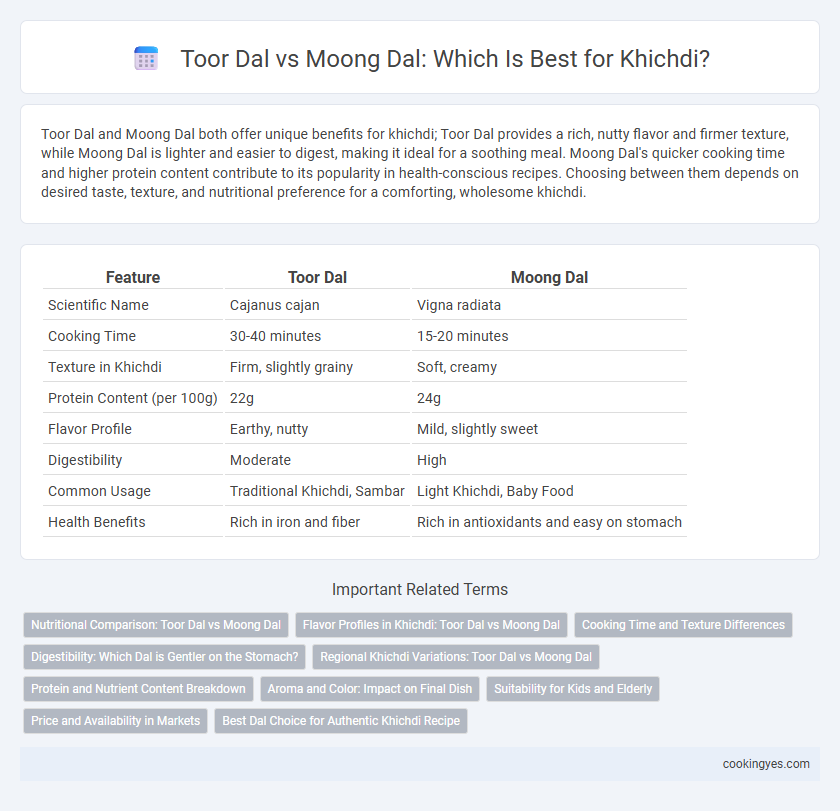Toor Dal and Moong Dal both offer unique benefits for khichdi; Toor Dal provides a rich, nutty flavor and firmer texture, while Moong Dal is lighter and easier to digest, making it ideal for a soothing meal. Moong Dal's quicker cooking time and higher protein content contribute to its popularity in health-conscious recipes. Choosing between them depends on desired taste, texture, and nutritional preference for a comforting, wholesome khichdi.
Table of Comparison
| Feature | Toor Dal | Moong Dal |
|---|---|---|
| Scientific Name | Cajanus cajan | Vigna radiata |
| Cooking Time | 30-40 minutes | 15-20 minutes |
| Texture in Khichdi | Firm, slightly grainy | Soft, creamy |
| Protein Content (per 100g) | 22g | 24g |
| Flavor Profile | Earthy, nutty | Mild, slightly sweet |
| Digestibility | Moderate | High |
| Common Usage | Traditional Khichdi, Sambar | Light Khichdi, Baby Food |
| Health Benefits | Rich in iron and fiber | Rich in antioxidants and easy on stomach |
Nutritional Comparison: Toor Dal vs Moong Dal
Toor dal contains approximately 22 grams of protein and 57 grams of carbohydrates per 100 grams, providing a rich source of energy and muscle-building nutrients in khichdi. Moong dal offers 24 grams of protein and 59 grams of carbohydrates per 100 grams, along with higher fiber content that aids digestion and stabilizes blood sugar levels. Both dals are rich in essential minerals like iron, potassium, and magnesium, but moong dal's lower fat content makes it a lighter, more easily digestible option for khichdi.
Flavor Profiles in Khichdi: Toor Dal vs Moong Dal
Toor dal offers a nutty, rich flavor that enhances khichdi with a slightly earthy taste, making it a traditional choice in many Indian households. Moong dal imparts a milder, slightly sweet flavor, resulting in a lighter, more delicate khichdi often preferred for its subtlety and ease of digestion. Both dals contribute unique texture and flavor nuances, with toor dal providing a firmer bite and moong dal offering a softer, creamier consistency.
Cooking Time and Texture Differences
Toor dal cooks slower than moong dal, requiring around 25-30 minutes compared to moong dal's 15-20 minutes, making the latter more suitable for quicker khichdi preparation. The texture of toor dal is firmer and grainier, offering a slightly nutty taste, while moong dal becomes softer and creamier, enhancing the khichdi's smooth consistency. Choosing moong dal results in a lighter, easily digestible khichdi, whereas toor dal gives a richer, more robust texture.
Digestibility: Which Dal is Gentler on the Stomach?
Moong dal is widely recognized for its superior digestibility compared to Toor dal, making it gentler on the stomach, especially for those with sensitive digestion or during illness. Its lower fiber content and simpler protein structure enable easier breakdown and absorption, reducing the likelihood of bloating or gas. In contrast, Toor dal, while rich in nutrients, contains more complex carbohydrates that can be harder to digest, potentially causing mild digestive discomfort.
Regional Khichdi Variations: Toor Dal vs Moong Dal
Regional khichdi variations highlight the choice between Toor Dal and Moong Dal, each lending distinct flavors and textures to the dish. Toor Dal, prevalent in South Indian and Maharashtrian khichdi recipes, offers a nutty taste and firmer texture, enriching the dish's robustness. In contrast, Moong Dal, favored in North Indian and Bengali preparations, results in a lighter, creamier khichdi with quicker cooking times, emphasizing comfort and digestibility.
Protein and Nutrient Content Breakdown
Toor Dal contains approximately 22% protein and is rich in dietary fiber, folate, and iron, making it a nutritious option for khichdi that supports digestion and energy metabolism. Moong Dal offers about 24% protein and has a higher concentration of essential amino acids along with vitamins like B-complex and minerals such as magnesium, which enhance muscle repair and overall health. Both dals provide plant-based protein and vital nutrients but Moong Dal's superior protein quality and nutrient density make it ideal for a more wholesome khichdi.
Aroma and Color: Impact on Final Dish
Toor Dal imparts a rich, nutty aroma and a vibrant yellow-orange color to khichdi, creating an inviting and warm appearance. Moong Dal offers a subtler fragrance with a pale yellow hue, resulting in a lighter and more delicate dish visually and aromatically. The choice between Toor Dal and Moong Dal significantly influences the khichdi's sensory appeal, affecting both its aroma intensity and color vibrancy.
Suitability for Kids and Elderly
Toor Dal offers a robust, nutty flavor and is rich in protein and fiber, making it suitable for elderly individuals who require easily digestible, nutrient-dense foods. Moong Dal, being lighter and softer, is highly recommended for children and elderly due to its gentle digestion and high vitamin content, particularly folate and iron. Both dals support heart health and provide essential amino acids, but Moong Dal's quick cooking time and mild taste make it more adaptable for delicate palates in khichdi.
Price and Availability in Markets
Toor Dal is generally more expensive than Moong Dal, reflecting its higher demand and slightly longer cooking time, which influences the overall cost of khichdi preparation. Moong Dal is widely available in most markets year-round, often at lower prices, making it a cost-effective choice for budget-conscious consumers. Both dals have good availability, but Moong Dal's affordability and quicker cooking make it a preferred option for everyday khichdi.
Best Dal Choice for Authentic Khichdi Recipe
Toor Dal and Moong Dal both serve as excellent choices for authentic khichdi, but Moong Dal is preferred for its lighter texture and quicker cooking time, enhancing the mushy consistency characteristic of traditional khichdi. Toor Dal offers a robust, earthy flavor and retains a slightly firmer bite, making it ideal for a heartier variation. Nutritionally, Moong Dal is richer in protein and easier to digest, making it suitable for comfort food and balanced meals.
Toor Dal vs Moong Dal for Khichdi Infographic

 cookingyes.com
cookingyes.com